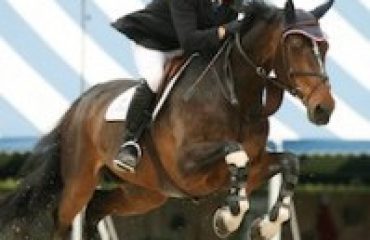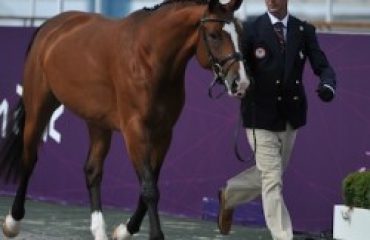 Richard Wheeler, DVM, was born in the U.K. and graduated from the Royal Veterinary College, London, in 2002. Dr. Wheeler then completed a two-year internship at Greenwood, Ellis and Partners (now Newmarket Equine Hospital) in Newmarket. In 2005, he moved to Wellington, Florida, to join Palm Beach Equine Clinic and he became a partner in 2009. Dr. Wheeler’s primary concentration is equine sports medicine. He is an FEI Veterinary Delegate for show jumping and dressage and has authored several published articles on the topic of equine sports medicine. Dr. Wheeler has served on the board of the USHJA Horse and Rider Advocates Committee. In 2016, Dr. Wheeler became a founding director of the Sport Horse Research Foundation. Dr. Wheeler and his wife, Jessica, have two children. Do you have a question you want Dr. Wheeler to answer? Send questions to editor@sidelinesnews.com.
Richard Wheeler, DVM, was born in the U.K. and graduated from the Royal Veterinary College, London, in 2002. Dr. Wheeler then completed a two-year internship at Greenwood, Ellis and Partners (now Newmarket Equine Hospital) in Newmarket. In 2005, he moved to Wellington, Florida, to join Palm Beach Equine Clinic and he became a partner in 2009. Dr. Wheeler’s primary concentration is equine sports medicine. He is an FEI Veterinary Delegate for show jumping and dressage and has authored several published articles on the topic of equine sports medicine. Dr. Wheeler has served on the board of the USHJA Horse and Rider Advocates Committee. In 2016, Dr. Wheeler became a founding director of the Sport Horse Research Foundation. Dr. Wheeler and his wife, Jessica, have two children. Do you have a question you want Dr. Wheeler to answer? Send questions to editor@sidelinesnews.com.
My 11-year-old OTTB is normally very kind-natured but recently became grouchy when I was putting the saddle on, pinning his ears. My vet has diagnosed him with kissing spines. We gave him some time off, weekly acupuncture treatments and have treated him with gabapentin. Talking with friends, I have heard many stories ranging from horses successfully competing with the condition to others that had to be retired. What surgical options are there and how successful are they?
As this is a surgical question, I referred to one of our board certified surgeons, Dr. Weston Davis, who has successfully performed many surgeries for kissing spines.
Kissing spines was once a disease that many horses were retired for, but that’s rarely the case anymore.
Kissing spines refers to an abnormal conformation in the back, whereby the dorsal spinous processes (the bony processes extending up from each vertebra) impinge or overlap with those from adjacent vertebrae. In humans, this is referred to as Baastrup’s disease. Pain in these cases may be caused by impingement and local inflammation, spasm of the epaxial muscles, spinal malalignment in more severe cases where the spinous processes actually overlap or a combination thereof. This condition most frequently occurs in the mid- to caudal thoracic region (just under or behind the saddle).
Diagnosis in these cases can be complicated, and appropriate care must be taken in the clinical work-up. It’s important to first note that there are many horses with radiographic changes consistent with kissing spine disease who are free from back pain and perform sporting activities at high levels. We often detect this abnormality in sound horses during pre-purchase screening.
History is a crucial part of the diagnosis. Owners often report behavioral changes in these horses with a generally poor attitude and tail swishy/ears back-type demonstrations of their discontent for brushing over the back, saddling and riding activities. Clinical horses may resent specific riding activities such as a seated trot. In certain sports, activities that cause hyperextension of the back may exacerbate signs resulting in behavior that could range from tail swishing to explosive bucking. Examples would be a jumper hyperextending the back on landing, or a barrel horse hyperextending the back while rounding the second half of a barrel in a tight turn.

Interspinous Ligament Desmotomy with scissors
Clinical examination in these cases almost always demonstrates marked sensitivity on palpation of the epaxial muscles of the back. Reaction to palpation directly over the dorsal spinous processes is variable. Depending on the severity of the disease, horses may have secondary wasting of the topline musculature (this results in worsening of the disease due to lack of muscular support and stabilization). Some horses have a concave appearance to the topline (sway-back); however, in most sport horses with one or two sites affected, outward conformation is generally normal. When lunged, affected horses often carry themselves rigidly through the back with their topline looking more like a board than a freely moving connection between the front and hind limbs. Ridden exam may be performed with activities to exacerbate the clinical signs, but care should be taken for the safety of the rider. In some cases that are consistently symptomatic, blocking can be very useful to support a diagnosis. Using a short-acting local anaesthetic (carbocaine), affected sites may be blocked with radiographic or ultrasound guidance. The horse is then returned to activity 10–15 minutes later. If this significantly reduces symptoms, the diagnosis is strongly supported.
Imaging in these cases is performed with digital radiography. With the improved quality of most machines, survey radiographs for kissing spines may be performed in the field. In some cases, scintigraphy (or bone scan) may be performed to determine how much bony reaction/turnover is noted at the impinging sites and to rule out other abnormalities of the spine. Ultrasound can also be useful to look at soft tissues and the articulations between the vertebrae.

Dorsal Spinous Process Ostectomy with single DSP removed
Once a confident diagnosis is made, most horses are treated conservatively at first. Perfect saddle fit should be confirmed. Carrot stretches are performed twice daily. Muscle relaxants such as methocarbamol are often administered for 10–14 days to reduce muscle spasm. Horses are trained to lunge in a Pessoa-type apparatus to encourage collection and strengthen the topline. A recent study has also shown merit for standing vibration techniques such as TheraPlate for increasing the mass of spinal stabilizing muscles. Local cortisone injections at the affected sites are often performed in more severe cases. In my case population, upwards of 90 percent of cases are manageable with conservative measures alone.
In horses that are refractory to conservative therapies, there are several surgical options with good success rates. The specific procedure recommended will vary depending on the case (severity of disease and the number of sites affected), but all procedures may be performed with the patient under standing sedation and a local block. Interspinous Ligament Desmotomy is the least invasive surgery type and involves making a small stab incision through the skin and simply cutting the ligament between two impinging vertebrae. Dorsal Spinous Process Osteplasty is a procedure performed in more severely affected horses whereby the bone of the dorsal spinous processes is reshaped. Dorsal Spinous Process Ostectomy is the most aggressive procedure whereby the entire dorsal spinous processes are removed. Outcome and return to full athletic activity with all surgery types is favorable and horses generally resume riding activities within 30–60 days.













